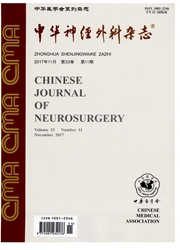

 中文摘要:
中文摘要:
目的建立大鼠坐骨神经移植神经鞘瘤模型,为临床治疗神经鞘瘤的研究提供稳定、有效的动物模型。方法健康成年雄性SD大鼠15只,采用随机数字法随机均分为原代模型组、RT4模型组及对照组,每组5只。分别给予3组大鼠坐骨神经鞘内注射等量的人前庭神经鞘瘤原代细胞、大鼠神经鞘瘤RT4细胞悬液及生理盐水。术后1周起对各组大鼠的坐骨神经功能进行测试。术后4周观察坐骨神经的成瘤情况,并行病理学检查确定肿瘤的组织学类型。结果2个模型组与对照组比较,术后术侧后肢五趾间距均明显变小,术后第14天开始差异有统计学意义(P〈0.05);与健侧比较,2个模型组术侧后肢五趾间距变小,术后第7天开始差异有统计学意义(P〈0.05);与对照组比较,2个模型组大鼠在支架上停留时间均缩短,术后第7天开始差异即有统计学意义(P〈0.01)。2个模型组大鼠注射肿瘤细胞4周内均在坐骨神经成瘤,肿瘤标本经HE染色后确认为神经鞘瘤,免疫组化染色显示S-100在细胞膜和细胞质均呈阳性表达。结论大鼠坐骨神经移植神经鞘瘤细胞后可在移植部位成瘤。
 英文摘要:
英文摘要:
Objective To establish a stable and effective schwannoma xenograft model in rats for the study of its clinical treatment. Methods Fifteen rats were randomly divided into 3 groups according to random number table. RT4 cells and human schwannoma cells were injected into the sheath of sciatic nerve in the model groups, and normal saline was injected into the control group. Function tests of sciatic nerves were performed since the first week after tumor implantation. We observed the tumors during the following 4 weeks,which were identified by pathological examination. Results Compared with controls, the space between toes of right hind limbs in model groups was reduced after operation. There was significant difference in the space of right toes between 3 groups 14 days post operation (P 〈 0.05). There was significant difference between the left and right limbs in model groups 7 days post operation (P 〈 0.05 ). Compared with the rats in control groups, the time standing on the pole of rats in the 2 model groups was reduced significantly 7 days after operation ( P 〈 0.05). Rats in the 2 model groups developed tumors within 4 weeks after tumor implantation. Schwannoma were identified in all cases by HE staining. The results of immunohistochemical examination demonstrate that cell membrane and cytoplasm were positive for S-100. Conclusion Xenograft schwannoma can be developed in sciatic nerves after tumor implantation.
 同期刊论文项目
同期刊论文项目
 同项目期刊论文
同项目期刊论文
 期刊信息
期刊信息
